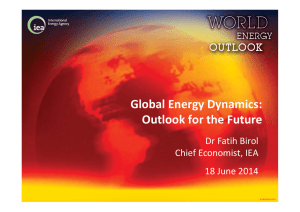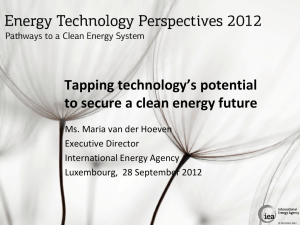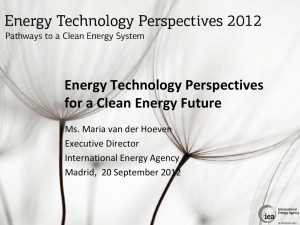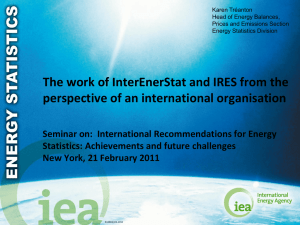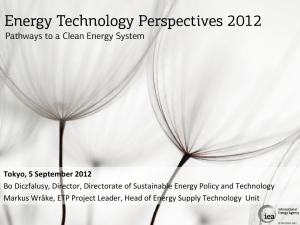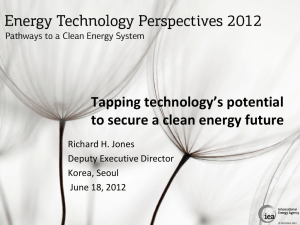BD presentation - Arctic Forum Foundation
advertisement
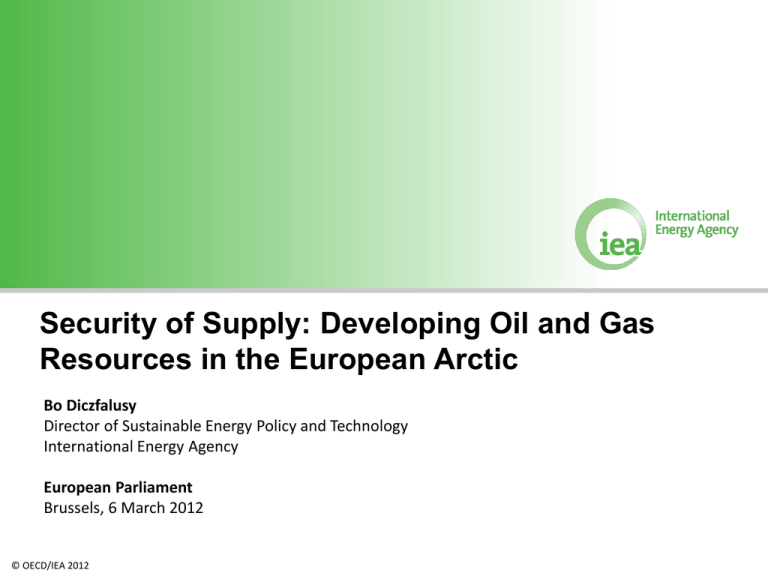
Security of Supply: Developing Oil and Gas Resources in the European Arctic Bo Diczfalusy Director of Sustainable Energy Policy and Technology International Energy Agency European Parliament Brussels, 6 March 2012 © OECD/IEA 2012 Policies could radically alter the longterm energy outlook World primary energy demand by scenario Mtoe 20 000 Current Policies Scenario 18 000 New Policies Scenario 16 000 14 000 450 Scenario 12 000 10 000 8 000 6 000 1980 1990 2000 2010 2020 2030 2035 In the New Policies Scenario, demand increases by 40% between 2009 & 2035 © OECD/IEA 2012 Source: World Energy Outlook 2011 The age of fossil fuels is far from over, but their dominance declines Shares of energy sources in world primary energy demand in the New Policies Scenario 50% Oil Coal 40% Gas Biomass 30% Nuclear Other renewables 20% Hydro 10% 0% 1980 1990 2000 2010 2020 2030 2035 Oil remains the leading fuel though natural gas demand rises the most in absolute terms © OECD/IEA 2012 Source: World Energy Outlook 2011 Most new oil production capacity is needed to offset decline mb/d World liquids supply by type in the New Policies Scenario 110 100 90 80 70 60 50 40 30 20 10 0 1990 Biofuels Processing gains Unconventional oil Natural gas liquids Crude oil: Yet to be found Yet to be developed Currently producing 2000 2010 2020 2030 2035 Decline at existing conventional fields amounts to 47 mb/d, twice current OPEC Middle East production; NGLs and unconventional production are the main sources of growth © OECD/IEA 2012 Source: World Energy Outlook 2011 Natural gas & renewables become increasingly important Mtoe World primary energy demand by fuel in the New Policies Scenario 5 000 Additional to 2035 4 000 2009 3 000 2 000 1 000 0 Oil Coal Gas Renewables Nuclear Renewables & natural gas collectively meet almost two-thirds of incremental energy demand in 2010-2035 © OECD/IEA 2012 Source: World Energy Outlook 2011 Is there enough oil? No carbon tax 6 © OECD/IEA 2012 Improved recovery could boost oil supply Cumulative oil, trillion barrels 7 © OECD/IEA 2012 Meeting the Arctic challenges Arctic resources (USGS): - 30% of yet-to-find natural gas - 13% of yet-to-find oil 8 © OECD/IEA 2012 Technology advances in hydrocarbon exploration and production Improved and enhanced oil recovery Deepwater exploration and production Meeting the Arctic challenges Protecting pristine environments Improvements in seismic imaging Non-conventional oil and natural gas LNG transportation 9 © OECD/IEA 2012 Deepwater exploration and production 10 © OECD/IEA 2012 Growth in subsea flowlines 11 © OECD/IEA 2012 Technical challenges of ice-prone regions Main challenges: - Avoid ice - Manage ice 12 © OECD/IEA 2012 Protecting pristine Arctic environments 13 © OECD/IEA 2012 Alpine (exploration site) in winter and summer Near-zero discharge facility - designed to minimise the environmental footprint 14 © OECD/IEA 2012 Tomorrow’s zero footprint oil and gas field developments © OECD/IEA 2012 Conclusions The projected demand for gas is higher in 2035 than in 2009 for all scenarios. For oil, it falls a little (-8%) in the 450 Scenario The share of gas in 2035, compared with that in 2009, increases by 1-2% and remains fairly consistent across all scenarios. Oil and gas resources exist, but they need to be converted into recoverable reserves Advances in technology are essential Accessing Arctic reserves presents technological and environmental challenges. © OECD/IEA 2012 Thank You bo.diczfalusy@iea.org © OECD/IEA 2012
